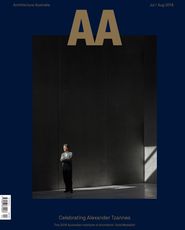Two conditions seem self-evident. Firstly, architectural practice is permeated with research: how else could things be so varied or be able to change so rapidly? Secondly, though, architects in Australia, Britain and elsewhere are hugely ineffective at defining or describing their research contributions. This results in diminished respect shown toward the discipline as well as the loss of potential fee income – errors, incidentally, not made by doctors or lawyers. Hence there is a strong collective need for architects to rectify the situation, with probably the greatest responsibility falling on larger practices, not least as their research work is inherently likely to be more diverse than that of smaller firms.
What, then, might be a more productive relationship between the research in larger practices and the institutional constellation of universities, professional bodies, governmental agencies and industrial partners? For the purposes of this essay, I am assuming that employing more than fifty staff represents a large architectural firm – that is the cut-off level used by the Royal Institute of British Architects (RIBA) to define “large practices,” with its figures for 2016 suggesting that these large practices – which comprise just 5 percent of all UK practices by number – nonetheless earned slightly over half of the £2.5 billion revenue earned by architects in the country that year.(1)
In this article I will initially discuss research structures, then financial aspects and the role of professional institutes. Insights are taken from my role as vice-dean of research at the Bartlett School of Architecture or from my time as chair of the Research and Innovation Group of the RIBA. While there will thus be a British inflection, many points are equally pertinent to Australia.
Dealing first with research structures, it is clear that there is a growing wish to involve architectural firms in government-funded research projects as part of the onus on universities to demonstrate the socioeconomic impact and relevance of their research. In this situation larger architectural practices, which tend to have longer and wider track records, are more likely to be accepted by funding bodies. Other initiatives also seem productive, for example PhD studies by employees within architectural companies – often termed “industrial doctorates” – and state-funded Knowledge Transfer Partnerships, with academics providing specialist training in new skills for the workplace. More fluid links can also be adopted. At the Bartlett School of Architecture we have set up the Centre for London Urban Design, run by a full-time academic (myself) and Peter Bishop as a part-time professor who is also a director of Allies and Morrison, one of the UK’s largest architecture and urban design practices. We pursue various research projects, mainly through day-release secondment of staff from sizeable London practices. For us, this provides the researchers we require; for the firms involved, it offers staff development and training, plus the chance to contribute to broader research initiatives not linked only to individual projects.
The financial side of research activity is regrettably under-explored by architects. Every country’s tax structure is different, yet good accountants and advisers should be able to find where tax breaks exist. In Britain, HM Revenue and Customs (formerly Inland Revenue) operates a general tax credit allowance for those elements of any company’s costs incurred in research and development – this being one of the few, and one of the largest, systems of state subsidy in the UK. At the RIBA we were keen to urge British architects to use this facility, circulating guidance to all firms. There is now an increasing take-up, generally saving an estimated £175,000 ($310,000) per year for a fifty-person practice, around £300,000 ($520,000) for a hundred-person firm and so on.(2) Practices then reinvest this tax saving back into the employment of research staff to carry out further investigations.
Institutionally, it is vital that any nation’s professional institute has a research committee. In Britain, after years of campaigning, we even finally have a RIBA vice-president for research: Professor Flora Samuel of the University of Reading. She was until recently the chair of the RIBA’s Research and Innovation Group and has written a number of useful guides, including a short essay in The Journal of Architecture in 2017 called “Supporting Research in Practice.” 3 The RIBA runs annual President’s Awards for Research that are open to firms and offers RIBA Research Trust Awards to enable practitioners to carry out research related to specific projects they are designing. The projects winning these latter awards are diverse, including, for instance, research by Suzi Winstanley of Penoyre and Prasad titled “ThinkSpace,” which explored potential new models for university libraries; Walter Menteth’s analysis of procurement processes via Project Compass; and Tonkin Liu’s beautiful investigation of Shell Lace Structure, as published in book form (The Evolution of Shell Lace Structure by Tonkin Liu).
Openness, transparency and mutual support are vital in encouraging not just the production of architectural research but also its dissemination. In Britain there is still unfortunately a divide between companies that tend to keep their research to themselves, so as to enhance their own competitive position, and those that realize that research needs to be freely shared. The role of a professional institute such as the RIBA is most pertinent when it focuses on the dissemination and rewarding of high-quality research, rather than trying to direct what ought to be investigated, given that practices are far more sensitive to the types of research required. In the RIBA committee, we preferred to nominate annual themes to stimulate research activity rather than control it, including issues such as how to design for an ageing population or the necessity for a specific ethics policy for our research field.
Elsewhere in Europe, a significant initiative I am involved in is being led by Michael Hensel at the Oslo School of Architecture in Norway, working also with Fredrik Nilsson at Chalmers University of Technology in Gothenburg, Sweden. Under the umbrella of “The Changing Shape of Practice,” a series of events have featured the research work of larger practices such as Snøhetta or Kieran Timberlake, feeding into an evolving series of Routledge books that includes The Changing Shape of Practice: Integrating Research and Design in Architecture (2016, edited by Michael Hensel and Fredrik Nilsson). Australia is already known as one of the world leaders in design research, due to the likes of Leon van Schaik’s program at RMIT University and its impact on design in Melbourne. The ground seems fertile for equivalent institutional openness and ambition in supporting research, in all its forms, within larger Australian architectural firms. One can only imagine the effect this could have on practice if put into implementation.
— Murray Fraser is vice-dean of research for the Faculty of the Built Environment at the Bartlett School of Architecture, University College London.
Footnotes
1. “RIBA Business Benchmarking 2015,” ribabenchmark. com/reports/The RIBA Business Benchmarking Report 2015. pdf and “RIBA Business Benchmarking 2016,” architecture.com/-/media/gathercontent/business-benchmarking/additional-documents/ribabenchmarking2016executivesummarypdf.pdf.
2. Based on information supplied confidentially to the author.
3. Flora Samuel, “Supporting Research in Practice,” The Journal of Architecture , volume 22 number 1, 2017, 4–10.
Source

Discussion
Published online: 8 Mar 2019
Words:
Murray Fraster
Images:
Dr Eva Branscome
Issue
Architecture Australia, July 2018
















